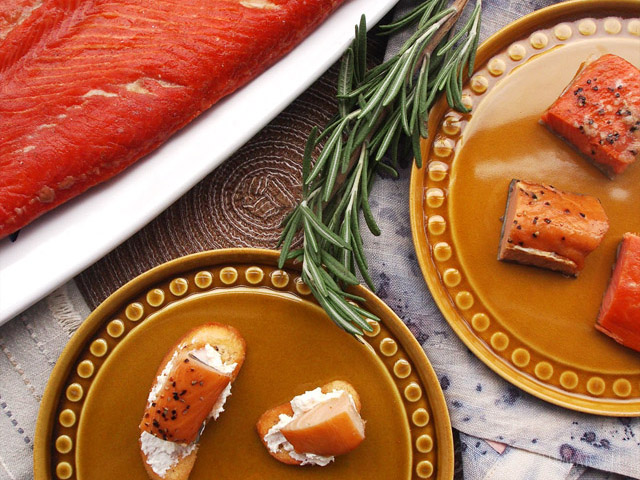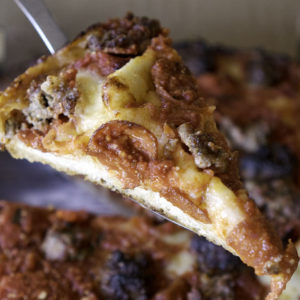
I’ll never forget when I got my own place and had to learn how to stock a pantry for the first time. I remember calling my mom for a list and then spending hours combing the food store trying to determine what I’d need.
I wouldn’t wish that on anyone, so I’m sharing a list of all the items I currently have in my pantry. Since how to stock a pantry for the first time is highly dependent on what type of cook you are, I provide both “the basics” and “extras” for those that are into cooking like me.
In addition to this pantry list template, I also share my favorite Pacific Northwest small-batch producers making some of my favorite pantry essentials. There are even links to recipes using my favorite pantry items for inspiration.
This post has affiliate links, which means I may earn a small commission at no cost to you if you click on them and make a purchase. This is a small way I earn money to support this site. If links aren’t showing up for you, turn off your ad blocking software. Thank you for your support!
How to Stock a Pantry for the First Time
First, let’s align on what “staples” mean. This list includes what I consider essentials: the goods that help you whip up a dish in a moment’s notice when you didn’t get to meal planning that week. I believe these are a priority when you’re creating a list for how to stock a pantry for the first time.
Since I don’t eat a lot of packaged foods, this list doesn’t include many pre-made items or snacks. It also doesn’t include perishables like fresh vegetables, fruits, or dairty that require refrigeration (though some of the condiments require refrigeration after opening).
Like I mentioned, I enjoy cooking, so what I consider a “staple” may be too much for you. That’s why I kept anything that might be a bit more obscure under the “extras” category.
Hopefully you find this shopping list helpful when stocking your pantry from scratch.

A note on buying from small businesses.
I love supporting local Pacific Northwest makers throughout my home, so my pantry is no different. Small businesses tend to produce smaller batches free of equipment and questionable ingredients. I prefer to support artisans taking pride in what they make and striving to produce the best version of their craft.
The result? Honestly, it just tastes better. Plus I feel good knowing I’m supporting a real person’s livelihood. So in each pantry item section, I added local small businesses (most of which ship!) making killer versions of these pantry staples. Consider adding them to your list of how to stock a pantry for the first time!
Spices & Seasonings
I put the spices below in alphabetical order so you can find them quickly (and I recommend you do the same when you add them to your cupboard!). While I have all these spices in my pantry, the ones in “the basics” section are what I use regularly. I’d stick with those when stocking a pantry for the first time unless there’s another spice you know you use often because spices lose their potency the older they are.

If you buy from a food store, buy in bulk to save money! I bought clear spice jars from Fred Meyer’s (a local version of a Walmart or Target, if you’re not from the Pacific Northwest) and used a label maker to identify them.
The basics:
- Allspice
- Bay leaf
- Cayenne
- Chili flakes
- Chili powder
- Cinnamon
- Coriander
- Cumin
- Curry powder
- Dry mustard
- Ginger
- Kosher salt
- Nutmeg (whole & ground)
- Oregano
- Paprika
- Pepper (I prefer whole peppercorns to put in a grinder)
- Thyme
Extras:
- Anise
- Basil
- Cacao nibs
- Caraway seeds
- Cardamom
- Celery seed
- Chinese five spice
- Chipotle powder
- Cloves
- Coriander seed
- Dukkah
- Garam masala
- Garlic powder
- Fennel seed
- Lavender
- Mustard seed
- Onion powder
- Rosemary
- Saffron
- Sage
- Smoked paprika
- Specialty blends (steak rubs, jerk seasoning, etc.)
- Specialty salts
- Sumac
- Turmeric
- Za’atar

PNW businesses that can stock these
Most of these spices aren’t grown in the US, but there are some small businesses in Washington taking great care in how they source and blend spices.
One of my favorite is The Kitchen Imp. She sources spices responsibly and sells them with easy-to-follow recipes. I’m obsessed with her dukkah, which is a spice blend common in Egypt. It can be made with a few variations of spices, but to give you an idea of what’s in it Melissa’s has almonds, sesame seeds, coriander, and cumin, and black pepper. She has an active Etsy store if you need shipping.
Another local option is Word Spice Merchants. This tiny spot is hidden in Pike Place Market, but is a place locals known to visit when exploring downtown Seattle. A lot of restaurants and chefs swear by them and, if you’re not from the area, they ship.
Looking for spices grown right here in Washington? Cyrus Saffron grows those delicate red threads in Lake Chelan, Washington, a fertile region known for its wineries. I haven’t tried their saffron yet, but I’ve seen them selling at the Ballard Farmer’s Market and am super intrigued that a spice is grown in our relatively moderate climate.
Recipe ideas using these pantry staples
- Carrot Parsnip Soup With Dukkah
- Turkey Chili With Chocolate
- Curry Stuffed Asian Sweet Potatoes
- Cacao and Tahini Cauliflower
- The Best Ever Spiced Applesauce

Oils & Vinegars
We cook Asian food a fair bit, so most of the items under “the extras” section I consider staples. However, I know not everyone does so I tried to be objective when putting together this checklist of how to stock a pantry for the first time! 😂
The basics
- Extra virgin olive oil
- Vegetable oil
- Canola oil
- Coconut oil
- Balsamic vinegar
- Red wine vinegar
- Distilled white vinegar (also a cleaning staple)
- Cooking spray
Extras
- Ghee (clarified butter)
- Sesame oil
- Mirin
- Rice vinegar
- Specialty oils (walnut, avocado, peanut, etc.)
- Specialty vinegars (champagne, white, apple cider, etc.)

PNW businesses that can stock these
Washington producers are creating interesting alternative oils using local ingredients. One of them is Camelina Gold. It’s made with camelina, an ancient plant in the crucifer/Brassica family alongside broccoli and cabbage. It used to be popular before the Industrial Revolution, but lost favor because it can’t be hydrogenated easily. Luckily it’s coming back because of it’s high levels of Omega-3s and vitamin E. It’s an oil that can tolerate high heats and adds a interesting grassy note to dishes.
Recipe ideas using these pantry staples
- Blueberry, Corn, and Israeli Couscous Salad
- Salad With Honey, Pea Vines, and Chive Cheese
- Slow-Cooked Pork Asian Rice Bowls
Canned & Jarred Goods
Canned and jarred goods are a must when you’re looking how to stock a pantry for the first time. They can be a lifesaver when you need a quick meal.
The basics:
- Tomatoes (whole at minimum, crushed & diced nice too)
- Tomato paste
- Chickpeas
- Black beans
- White beans like cannellini
- Coconut milk
- Canned chipotle peppers
- Diced green chiles
- Peanut butter
- Jelly
- Tuna
- Sardines
- Anchovies
- Stock (vegetable, chicken, beef)
- Tahini
Extras:
- Applesauce
- Olives
- Roasted peppers
- Other canned beans (kidney, pinto, etc.)
- Other stocks or broths (fish stock, bone broth, clam juice, etc.)
- Specialty butters (almond, cashew, etc.)
- Specialty sauces (curry, pasta sauce, etc.)
- Specialty canned fish (salmon, herring, clams, etc.)

PNW businesses that can stock these
Being that we have access to the best salmon in the world, there are a few Washington companies worth seeking out to stock up on canned or packaged salmon. For example, Seabear Smokehouse is a company located in Anacortes about 1.5 hours north of Seattle. They offer a variety of seafood, but my favorite is their ready-to-eat salmon packets that are similar in texture and convenience to canned tuna.
If you want the freshest salmon you can get, check out Drifter’s Fish. It’s a husband-and-wife fishing team who goes to Alaska every spring/summer and comes back with fish that you can enjoy through either their smoked canned goods or CSF (community-supported fishery, like a produce CSA but with fish!).

If you’re less into canned fish, there are a lot of other amazing Pacific Northwest makers creating jarred pantry staples. For example, I discovered Just Eat Me (JEM) Organics at a craft fair and fell in love with their nut butters made in Bend, Oregon. The cashew cardamom butter is out of this world.
Or, if you like stocking your pantry with sauces that you can use to whip up a quick meal, try Mesa de Vida. I don’t usually use jarred sauces, but Chef Kirsten Helle Sandoval used to be the private chef for the Seahawks football team and created these healthy, cajun-inspired sauces that are quite good.
Recipe ideas using these pantry staples
- Stuffed Shell Pasta Recipe With Smoked Salmon
- Creole Shrimp and Steak Fajitas
- Italian Fish Soup
- Steak With a Rosemary Jam Crust

Baking Staples
I’m not a huge baker, but I have all of these items on hand.
The basics:
- All-purpose flour
- Granulated sugar
- Confectioner’s sugar (powdered sugar)
- Cornmeal
- Brown sugar
- Baking soda
- Baking powder
- Cornstarch
- Vanilla extract
- Cocoa powder
- Molasses
- Honey
Extras:
- Specialty flours (whole grain, cake, almond, etc.)
- Chocolate chips
- Almond extract
- Yeast
- Oats
- Corn syrup
- Condensed milk
- Pancake mix
- Gelatin
- Cake/brownie mix
- Coconut flakes
- Canned pumpkin
- Specialty sweeteners (agave, pomegranate molasses, etc.)

PNW businesses that can stock these
Washington is made up of a ton of farmland, so grains are a big crop here. In fact, Washington State University has a whole program dedicated to the study of grains, sustainable farming, and reviving ancient strands. They’re located in the Skagit Valley, which is where we’re going on my Washington food retreat.
One company developing some of the best flour I’ve ever used is Shepherd’s Grain. It’s a farmer cooperative dedicated to sustainably growing grain. Shepherd’s Grain takes the farmers’ crops and mills them into flour that I can only describe as “alive”. It’s extremely different than your typical all-purpose flour. I attended a panel with Shepherd’s Grain farmers and shared the experience on Instagram if you’re interested in learning more about what makes this flour special.
Speaking of flour, one of the most interesting alternative flours I discovered is coffee flour. This Washington-based business developed a way to turn discarded coffee cherries (the fruit that holds the bean) into a highly-nutritious flour. I interviewed the owners about coffee flour and it’s fascinating. Apparently coffee farms discard the cherry, which causes millions of tons of waste.
Finding a use for it not only reduces waste, but also helps these farmers earn more income.
Honey is a must when stocking your pantry for the first time, and luckily there are an abundance of small-batch honey producers in the Pacific Northwest. I took a fascinating class on urban beekeeping and harvesting honey with the Ballard Bee Company, where I learned fun facts like how if you move a bee hive just a few feet away from its original location, the bees can’t find it.
The owner of Ballard Bee Company sold his operations to Woodland Bee Company. While I haven’t tried their honey, I remember Ballard Bee Company’s honey being super flavorful and expect that Woodland Bee’s version is similar given the handoff of equipment and mentorship.
Another option is The Barreled Bee out of the Portland area. It’s owned by Lee Hedgmon, who works at local breweries around Portland. She took her knowledge of fermentation and applied it to honey, where she ages honey in old barrels from friends in the wine and spirits industry.
Recipe ideas using these pantry staples

Condiments & Sauces
The basics:
- Soy sauce (or tamari)
- Fish sauce
- Oyster sauce
- Worcestershire sauce
- Ketchup
- Mustard
- Mayo
- Salsa
- Maple syrup
- Curry paste
Extras:
- Sriracha
- Hot sauce
- Harissa paste
- Gochujang (Korean chili paste)
- Taco or enchilada sauce
- Miso
- Pickles (kosher pickles, pickled jalapeños, etc.)
- Specialty marinades & dressings
PNW businesses that can stock these
One of the most interesting discoveries I’ve made recently is Neil’s Big Leaf Maple Syrup made in Washington. Yes, you heard that right: maple syrup made from west coast sap. This is very unusual, so obviously I had to try it. The verdict? This maple syrup is super tasty. It’s not as rich as other east coast maple syrups I’ve had, yet it’s still deeply flavorful.
Recipe ideas using these pantry staples
- Sesame-Crusted Tuna With Maple-Miso Brussel Sprouts
- Faux-Fried Fish ‘Po Boy Sandwiches
- Healthy-ish Crock Pot Artichoke Dip
- Pumpkin Curry With Tofu

Pastas, Grains, & Dried Beans
As an Italian American, no pantry is complete without pasta!
The basics:
- Shaped pasta (I veer toward rotini, shells, bowties, and rigatoni)
- Long pastas (fettuccini is my top choice, but spaghetti and linguini count too)
- White and/or brown rice
- Quinoa
- Lentils (I always have black and red on hand)
Extras:
- Lasagna noodles
- Couscous
- Specialty rice (Jasmine, arborio, etc.)
- Specialty grains (farro, buckwheat, barley, etc.)
- Specialty beans (green lentils, etc.)
PNW businesses that can stock these
Bulebird Grain Farms is a small, family-run operation in Winthrop, Washington growing their own grain and selling unique varietals like wheat berries, farro, and more.
Recipe ideas using these pantry staples
- Easy Oven Risotto With Pesto and Corn
- Romesco-Lentil Meatballs With Pasta
- Lentil and Grain Mexican Stuffed Peppers
- Healthy Sunchoke Alfredo Sauce

Seeds & Nuts
These add great texture to dish…or a quick snack!
The basics:
- Sesame seeds
- Almonds
- Peanuts
- Walnuts
Extras:
- Cashews
- Pistachios
- Pine nuts
- Hazelnuts
- Sunflower seeds
- Pumpkin seeds (pepitas)
PNW businesses that can stock these
Willamette Valley in Oregon is known for its wine, but during my last trip there I learned that Oregon is a huge producer of hazelnuts. I’m hoping to visit a farm on my next visit so I can add it to my list of unique things to do in Oregon besides drink wine.
Even closer to home, I learned Holmquist Orchards is growing hazelnuts in Washington. I haven’t tried these yet, but they are available at the Ballard Farmers Market.
Recipe ideas using these pantry staples
- Citrus Salmon With Pistachio-Cacao Gremolata
- Cheddar Panko-Crusted Chicken With Apples
- Roasted Beet and Walnut Pesto
- Celery Root, Cauliflower, and Apple Soup With Pepitas

Other Packaged Goods
Here’s all the other items I think are important when you’re searching how to stock a pantry for the first time.
The basics:
- Coffee
- Tea
- Sun-dried tomatoes
- Panko breadcrumbs
- Taco shells
Extras:
- Dried fruit (raisins, craisins, etc.)
- Dried peppers
- Dried mushrooms
PNW businesses that can stock these
Seattle knows its coffee, and obviously locals think coffee is a must when trying to sort out how to stock a pantry for the first time. I have so many favorites that you can find in my guide on the best coffee in Seattle, but until then I encourage to seek out Vashon Island Coffee Roasters, Seattle Coffee Works, and Onda Origins.
Tea is often grown in Asia, but there’s a farm in Skagit Valley called Sakuma Brothers growing Japanese-style tea leaves right in Washington. I haven’t tried it yet, but I’m hoping to check out their farm for a future Skagit Valley food retreat.
Recipe ideas using these pantry staples
- Pumpkin Meatballs With Cranberries, Sage, and Pumpkin Gravy
- Arctic Char With Homemade Mango Tomatillo Salsa

Wine, Beer, & Spirits
What? Alcohol is essential to any pantry! While technically you can get by without booze, I find having them on hand helps when you need a splash of alcohol in a recipe.
The basics:
- Red wine
- White wine
- Light beer
Extras:
- Marsala wine
- Sherry
- Vermouth
- Vodka
- Dark beer
- Whiskey (I prefer bourbons)
- Rum
- Gin
- Specialty liqueurs (limoncello, ouzo, etc.)
PNW businesses that can stock these
A woman whose kid attends the same pre-school as my nieces co-owns a Seattle-based vodka and limoncello distilling company called Letterpress Distilling. I usually hate limoncello because I find it cloyingly sweet and an off-putting, artificial yellow color. Well, Letterpress Distilling’s version isn’t like that. It’s a subtle yellow hue and is made with only vodka, lemons, and some sugar. So it’s not too sweet and makes an excellent base for cocktails or savory dishes.

Another local distiller is making super interesting liqueurs in small batches out of the Tacoma, Washington area. Mastrogianni’s is a super small distillery in a nondescript warehouse that makes only 300 cases a year of Greek-style liquors like ouzo, grappa, and brandy. You can read more about this distiller’s story in my post about things to do in Tacoma, Washington.
Lastly, let’s not forget about wine and beer. Washington is the 2nd largest wine-producing region in the US behind California, and Oregon is the 3rd. And the craft beer scene is bananas in the Pacific Northwest (fun fact: Washington grows the most hops in the US). So the options for PNW-made beer and wine are endless.
You can find some of my favorite local breweries in my self-guide Seattle beer tour and favorite wines in my guides to the best Pacific Northwest wineries.
Recipe ideas using these pantry staples

And there you have it: how to stock a pantry for the first time using local, small-batch goods you can feel proud of. Hopefully this inspires you to order some items online before heading to the grocery store to fill out the rest of your pantry staples. And hopefully the recipes inspire some exciting new meals!
I’ll add more PNW made goods to this list as I discover them, so pin this guide for later!
How to Fill Your Home with Other PNW Goodies
- If you love oysters, consider buying oysters from Hama Hama Oyster company out of Washington and making these grilled oysters with cilantro curry and miso butter.
- Try this Washington company’s best store-bought ice cream.
- If you live in Seattle, fill your home with beautiful flowers through this floral arrangement subscription service
- Browse my gift guides featuring Pacific Northwest-made items.









